- Reasons Why Cherry Trees Don’t Bear Fruit:
- Lack of Pollination:
- Pollination Process:
- Possible Causes:
- Solutions:
- Insufficient Sunlight:
- 1. Prune nearby trees or shrubs:
- 2. Choose a sunny location:
- 3. Thin out the canopy:
- 4. Use reflective materials:
- Poor Soil Conditions:
- Nutrient deficiency:
- Poor drainage:
- pH imbalance:
- Compacted soil:
- Inadequate organic matter:
- Soil contamination:
- Lack of Pruning:
- Incorrect Tree Variety:
- Extreme Temperatures:
- High Temperatures:
- Low Temperatures:
- Pest Infestation:
- Disease and Fungal Infections:
- 1. Brown Rot:
- 2. Cherry Leaf Spot:
- 3. Powdery Mildew:
- 4. Bacterial Canker:
- Question-answer:
- Why is my cherry tree not bearing fruit?
- How long does it take for a cherry tree to produce fruit?
- What can I do to improve pollination for my cherry tree?
- How can I fertilize my cherry tree properly?
- What diseases are common in cherry trees?
- Can pruning affect cherry tree fruit production?
- Is it possible for cherry trees to be incompatible with rootstocks?
- Video: 4 Reasons Why Your Fruit Tree is Not Producing Fruit
Cherry trees are a beautiful addition to any garden, but what happens when they don’t produce fruit? There could be several reasons why your cherry tree isn’t bearing fruit, and it’s important to determine the cause in order to remedy the situation. In this article, we’ll explore nine possible reasons why cherry trees fail to bear fruit and provide some solutions for each situation.
1. Young Age: One common reason why cherry trees don’t produce fruit is that they are too young. Cherry trees generally take about three to five years to become mature enough to bear fruit. If your tree is younger than this, patience is key. Give it some time to establish itself before expecting fruit.
2. Pollination: Cherry trees require proper pollination in order to produce fruit. If there are no bees or other pollinators in your area, you may need to manually pollinate the flowers using a small brush. Additionally, planting a different variety of cherry tree nearby can help improve the chances of cross-pollination.
3. Lack of Sunlight: Cherry trees need plenty of sunlight to thrive and produce fruit. If your tree doesn’t receive at least six hours of direct sunlight each day, it may struggle to bear fruit. Consider pruning nearby trees or structures to increase sunlight exposure for your cherry tree.
4. Improper Pruning: Pruning is important for cherry trees, but improper pruning can hinder fruit production. Avoid heavy pruning during the winter months, as this can remove potential fruiting wood. Instead, focus on light pruning and shaping during the summer months.
5. Nutrient Deficiencies: Cherry trees require a balanced diet of nutrients to produce fruit. If your tree is not receiving enough essential nutrients, it may not be able to bear fruit. Conduct a soil test to determine if any nutrient deficiencies exist, and amend the soil accordingly.
6. Pest and Disease Issues: Cherry trees can be susceptible to a variety of pests and diseases that can inhibit fruit production. Common culprits include aphids, cherry fruit flies, and bacterial canker. Regularly inspect your tree for signs of pests or diseases, and take appropriate action to control and prevent further damage.
7. Climate Conditions: Cherry trees have specific climate requirements to produce fruit. They generally prefer temperate climates and require a certain number of chilling hours during winter. If you live in an area with extreme temperatures or insufficient chilling hours, your cherry tree may struggle to bear fruit.
8. Lack of Cross-Pollination: Some cherry tree varieties require cross-pollination from a different variety to produce fruit. If you only have one cherry tree, it may be unable to bear fruit due to the lack of a compatible pollinator. Planting a second cherry tree of a different variety nearby can help alleviate this issue.
9. Environmental Stress: Environmental factors such as drought, excessive heat, or extreme cold can cause stress to cherry trees and consequently inhibit fruit production. Ensure your tree is receiving adequate water, protection from extreme weather conditions, and proper care to minimize environmental stress.
By addressing these nine potential causes, you can determine why your cherry tree isn’t bearing fruit and take the necessary steps to remedy the situation. Whether it’s a matter of age, pollination, sunlight, pruning, nutrient deficiencies, pests and diseases, climate conditions, cross-pollination, or environmental stress, there is often a solution that can help your cherry tree thrive and start producing delicious fruit.
Reasons Why Cherry Trees Don’t Bear Fruit:
- Poor Pollination: Cherry trees require proper pollination to produce fruit. If there is a lack of pollinators such as bees or if the weather conditions during pollination are unfavorable, the tree may not bear fruit. Planting companion plants that attract pollinators can help improve pollination.
- Wrong Tree Variety: Not all cherry tree varieties are self-fertile, meaning they need another compatible cherry tree nearby for cross-pollination. Make sure that you have the right combination of cherry tree varieties for successful fruit production.
- Immature Tree: Young cherry trees may not bear fruit until they reach a certain age or maturity level. Be patient and allow the tree enough time to establish itself before expecting fruit production. This can take several years depending on the variety.
- Improper Pruning: Cherry trees require proper pruning to maintain their shape, remove dead wood, and promote healthy fruit production. Improper or excessive pruning can interfere with fruiting. Learn the correct pruning techniques for cherry trees or consult a professional arborist for assistance.
- Environmental Factors: Environmental factors such as insufficient sunlight, extreme heat or cold, or inadequate moisture can hinder the fruiting process. Ensure that the cherry tree is planted in an area with sufficient sunlight, proper drainage, and protection from extreme weather conditions.
- Pest and Disease Problems: Cherry trees are susceptible to various pests and diseases that can affect fruit production. Common pests include aphids, cherry fruit fly, and cherry slug. Diseases such as brown rot, black knot, and cherry leaf spot can also impact fruiting. Regular monitoring and appropriate pest control measures are necessary to prevent and manage these issues.
- Nutrient Deficiencies or Imbalances: Cherry trees require essential nutrients for healthy growth and fruit production. A lack of certain nutrients, such as nitrogen, phosphorus, or potassium, can inhibit fruiting. Conduct a soil test to determine if any nutrient deficiencies or imbalances exist and make amendments as necessary.
- Incorrect Watering: Over or under-watering can stress the cherry tree and disrupt fruit production. Provide regular, deep watering to ensure proper hydration without waterlogging the roots. Mulching around the base of the tree can help retain moisture and regulate soil temperature.
- Root or Grafting Issues: Damage to the root system or graft union can prevent the cherry tree from bearing fruit. Ensure that the tree is planted at the correct depth, and inspect the roots and graft union regularly for signs of damage or disease.
Identifying the specific reason why your cherry tree isn’t bearing fruit is essential for implementing the appropriate remedy. By addressing the underlying cause, you can improve the tree’s chances of producing a bountiful harvest of sweet cherries.
Lack of Pollination:
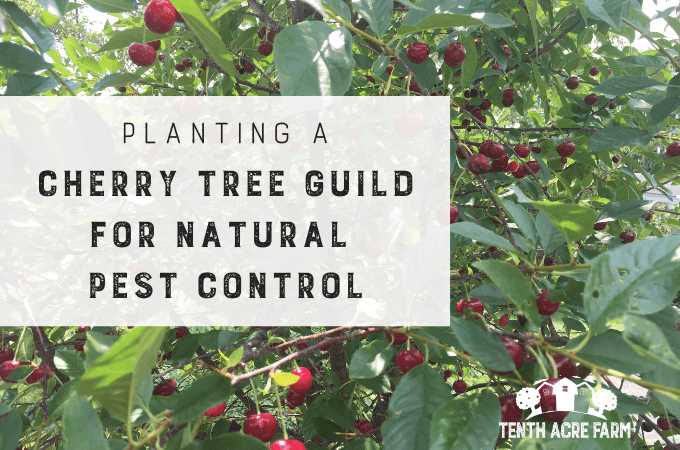
One of the main reasons why cherry trees may not bear fruit is due to a lack of pollination. Pollination is the transfer of pollen from the male organ of a flower to the female organ, resulting in fertilization and the production of fruit.
Pollination Process:
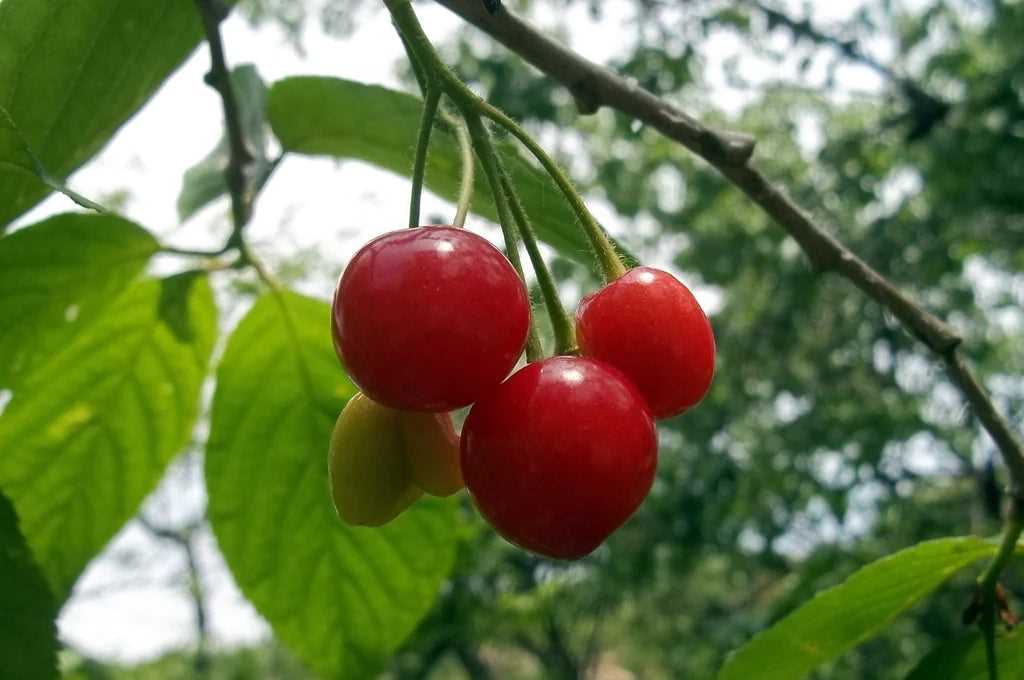
Cherry trees are primarily pollinated by bees and other insects. When a bee visits a cherry tree flower in search of nectar, pollen from the stamen (the male reproductive organ) sticks to the bee’s body. As the bee moves from flower to flower, some of this pollen is transferred to the pistil (the female reproductive organ), allowing pollination to occur.
Possible Causes:
There are several reasons why cherry trees may lack pollination:
- Lack of pollinators: If there is a shortage of bees or other pollinators in the area, the cherry tree may not receive adequate pollen for fertilization.
- Weather conditions: Unfavorable weather, such as rain or strong winds during the blooming period, can reduce pollinator activity and hinder pollination.
- Isolation: If the cherry tree is isolated from other compatible cherry varieties, there may not be enough pollen available for cross-pollination.
- Timing: The timing of blooming between cherry tree varieties is crucial for successful pollination. If the timing is not synchronized, cross-pollination may not occur.
Solutions:
To ensure proper pollination and increase fruit production, consider the following solutions:
- Introduce pollinators: Attract bees and other beneficial insects to the garden by planting flowers that provide nectar and pollen. Providing a suitable habitat with water sources can also help attract pollinators.
- Hand pollination: If pollinators are scarce or the weather conditions are unfavorable, you can manually transfer pollen between flowers using a small brush or cotton swab.
- Plant compatible varieties: Plant different cherry tree varieties that bloom at the same time to facilitate cross-pollination. Check with local nurseries or agricultural extension services for recommended varieties.
- Consider fruit tree guilds: Creating a fruit tree guild, which involves companion planting with other beneficial plants, can attract more pollinators and increase overall pollination rates.
By addressing the lack of pollination, you can increase the chances of your cherry trees bearing fruit and enjoy a bountiful harvest. Remember to monitor pollinator activity and take appropriate actions to promote successful pollination.
Insufficient Sunlight:
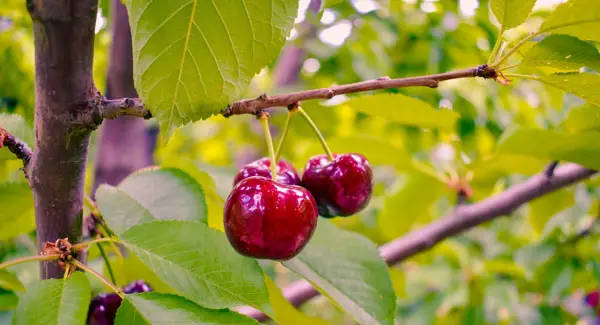
One of the most common reasons why cherry trees fail to bear fruit is the lack of sufficient sunlight. Cherry trees are sun-loving plants and they require at least 6 to 8 hours of direct sunlight daily to thrive and produce fruit.
When cherry trees do not receive enough sunlight, it negatively affects their ability to photosynthesize and produce energy needed for fruit production. This can result in reduced flower buds and poor fruit set.
If your cherry tree is not getting enough sunlight, there are a few steps you can take to remedy the situation:
1. Prune nearby trees or shrubs:
If there are any trees or shrubs nearby casting shade on your cherry tree, consider pruning them to allow more sunlight to reach the tree. This will help improve its overall health and fruit production.
2. Choose a sunny location:
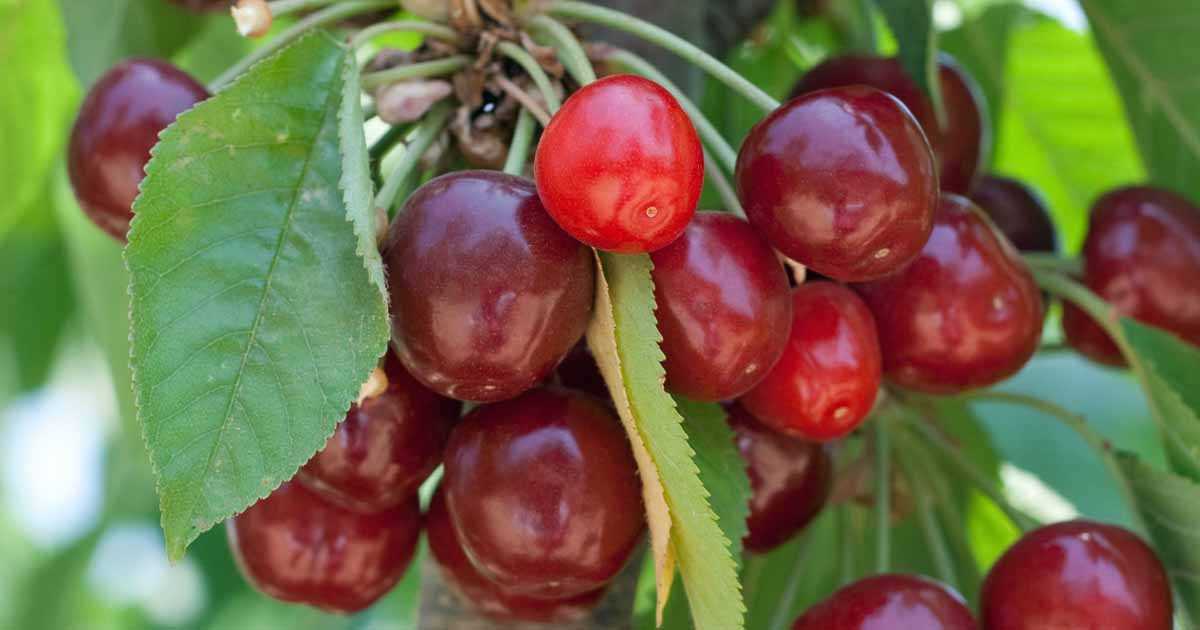
When planting a cherry tree, choose a location that receives full sun for most of the day. Avoid planting it in areas that are shaded by buildings or other structures.
3. Thin out the canopy:
If your cherry tree has a dense canopy, consider thinning it out to allow more sunlight to penetrate through the branches. This can be done by selectively pruning some of the branches to create openings.
4. Use reflective materials:
You can also use reflective materials, such as aluminum foil or white plastic, to redirect sunlight towards your cherry tree. Place these materials strategically in the garden to maximize the amount of sunlight reaching the tree.
By addressing the issue of insufficient sunlight, you can help your cherry tree thrive and increase its chances of bearing fruit.
Poor Soil Conditions:
Poor soil conditions can greatly affect the fruit-bearing capability of cherry trees. There are several factors related to soil conditions that can cause cherry trees to not bear fruit:
Nutrient deficiency:
Cherry trees require a balanced supply of essential nutrients to produce healthy fruit. If the soil lacks certain nutrients such as nitrogen, phosphorus, or potassium, it can hinder the tree’s ability to develop and bear fruit. A soil test can help identify any nutrient deficiencies and guide you in selecting the appropriate fertilizers to amend the soil.
Poor drainage:
Cherry trees prefer well-draining soil. If the soil retains excess water or becomes waterlogged, it can suffocate the tree’s roots and lead to root rot. As a result, the tree may not receive the necessary nutrients and oxygen to produce fruit. Ensuring proper drainage by amending the soil with organic matter or installing drain tiles can help improve the soil conditions for cherry trees.
pH imbalance:
The pH level of the soil plays a crucial role in the nutrient availability for cherry trees. They generally prefer slightly acidic to neutral soil with a pH range of 6.0 to 7.0. If the soil is too acidic or alkaline, it can affect nutrient uptake and hinder fruit production. Conducting a soil pH test and adjusting it accordingly through soil amendments can help create favorable conditions for cherry trees to bear fruit.
Compacted soil:
Compacted soil can restrict the tree’s root growth and prevent proper nutrient absorption. It also inhibits water infiltration, leading to poor drainage. The lack of oxygen in compacted soil can cause stress to the cherry tree and reduce its fruit production. Loosening the soil with a garden fork or aeration equipment can help alleviate compaction and promote healthy root development.
Inadequate organic matter:
Cherry trees benefit from the presence of organic matter in the soil. Organic matter improves soil structure, increases water-holding capacity, and enhances nutrient availability. Lack of organic matter can result in poor soil conditions that hinder fruit production. Incorporating compost, leaf mulch, or well-rotted manure into the soil can increase organic matter content and improve overall soil health for cherry trees.
Soil contamination:
In some cases, soil contamination can affect cherry tree fruit production. Chemical pollutants, heavy metals, or excessive pesticide residues can accumulate in the soil and harm the tree’s health. This contamination can inhibit flowering and fruit set or lead to deformed fruits. Soil testing for contaminants and implementing appropriate remediation measures, such as soil removal or selecting resistant cherry tree varieties, can help mitigate the impact of soil contamination.
Lack of Pruning:
One possible reason why cherry trees don’t bear fruit is the lack of pruning. Pruning is an essential practice for fruit trees, including cherry trees, as it helps promote the growth of new branches and stimulates the production of flowers and fruits.
When cherry trees are not pruned regularly, it can result in overcrowding of branches, which leads to poor air circulation and limited sunlight penetration. These conditions can negatively affect the tree’s health and its ability to develop flowers and fruits.
Pruning allows for the removal of dead, damaged, or diseased branches, ensuring that the tree’s energy is focused on producing fruits. It also helps maintain the tree’s overall shape and size, making it easier to manage and harvest.
Regular pruning should be done during the tree’s dormant period, typically in late winter or early spring. It is important to use proper pruning techniques and tools to avoid causing damage to the tree.
Steps to prune a cherry tree:
- Start by removing dead, damaged, or diseased branches, cutting them back to the main trunk or a healthy side branch.
- Remove any crossing or rubbing branches to prevent damage and promote proper airflow.
- Thin out the canopy by removing some of the older or less productive branches.
- Trim back the remaining branches to maintain an open and balanced shape, taking care not to remove too much of the tree’s foliage.
After pruning, it is important to clean up and dispose of any pruned branches and debris properly. This reduces the risk of spreading diseases and pests to the tree.
Regular pruning, combined with proper care and maintenance, can help ensure that cherry trees bear fruit consistently and produce a bountiful harvest year after year.
Incorrect Tree Variety:
In some cases, the cherry tree may not bear fruit due to the incorrect tree variety being planted. This can happen if the tree was mislabeled or if the wrong variety was chosen for the specific climate and growing conditions.
Cause:
- Planting the wrong cherry tree variety for the climate and growing conditions.
- Mislabeling of the tree variety.
Remedy:
- Research and choose cherry tree varieties that are well-suited for your specific climate and growing conditions.
- Consult with local experts or nurseries to ensure you select the correct variety.
- If the tree was mislabeled, consider replacing it with the correct variety.
By selecting the correct cherry tree variety, you can increase the chances of fruit production and ensure a successful harvest.
Extreme Temperatures:
Extreme temperatures can have a significant impact on the fruit-bearing ability of cherry trees. Both excessively high and low temperatures can interfere with the process of pollination and fruit development.
High Temperatures:
- During hot weather, cherry blossoms can experience premature wilting and falling off before they are pollinated. This can result in a lack of fruit set.
- Additionally, high temperatures can cause damage to the cherry tree’s reproductive organs, such as the pistil and stamens. This damage can prevent proper pollination and reduce fruit production.
- High temperatures can also increase the rate of water evaporation, leading to dehydration and stress in cherry trees. This stress can affect their overall health and reduce fruit production.
Low Temperatures:
- Chilling temperatures during the flowering season can cause damage to the cherry blossoms, leading to reduced fruit set. Frost can also kill the blossoms, resulting in a complete loss of fruits.
- Extremely cold winters can damage the cherry tree branches and buds, limiting their ability to produce flowers and fruit in the following season.
- Low temperatures can also delay the bloom timing of cherry trees, causing them to miss the ideal window for pollination and fruit development. This can result in poor fruit set.
To mitigate the effects of extreme temperatures, you can take several measures:
- Plant cherry tree cultivars that are more resilient to high or low temperatures.
- Provide shade or shelter during extremely hot weather to reduce stress on the cherry tree.
- Use windbreaks or other protective measures to prevent cold air from damaging the cherry tree during winter.
- Consider mulching around the base of the tree to insulate the roots and regulate soil temperature.
- Water the cherry tree adequately during heatwaves to prevent dehydration and stress.
- Monitor weather forecasts and take preemptive measures, such as covering the tree with frost blankets, during periods of expected frost or extreme temperatures.
By addressing the impact of extreme temperatures on cherry trees, you can improve the fruit-bearing ability of your cherry tree and enjoy a bountiful harvest.
Pest Infestation:
Pest infestation can also be a reason why cherry trees don’t bear fruit. Some common pests that can affect cherry trees include:
- Aphids: These small insects feed on the sap of cherry trees and can cause damage to the leaves and fruit.
- Mites: Mites are tiny pests that can cause discoloration and deformation of leaves and fruit.
- Cherry fruit fly: This pest lays its eggs on cherry fruits, causing them to become discolored, rot, and drop prematurely.
- Sawflies: Sawflies are caterpillar-like insects that chew on the leaves of cherry trees, causing defoliation.
If your cherry tree is infested with pests, it’s important to take action to control and eliminate them. Here are some remedies you can try:
- Pruning: Prune off any infested branches or leaves and dispose of them properly to prevent the pests from spreading.
- Beneficial insects: Introduce beneficial insects, such as ladybugs or lacewings, that feed on pests like aphids or mites.
- Chemical pesticides: If the infestation is severe, you may need to use chemical pesticides. However, make sure to choose products that are specifically labeled for use on cherry trees and follow the instructions carefully.
- Sanitation: Keep the area around the cherry tree clean and free of debris, as this can attract pests.
- Regular inspection: Monitor your cherry tree regularly for signs of pest infestation, so you can take action early on.
By addressing and controlling any pest infestations, you can help your cherry tree to thrive and increase its chances of bearing fruit.
Disease and Fungal Infections:
Disease and fungal infections are common reasons why cherry trees fail to bear fruit. These infections can weaken the tree, hinder its ability to produce fruit, and reduce overall productivity. Identifying the specific disease or fungal infection is crucial to implementing the appropriate remedy.
1. Brown Rot:
Brown rot is a common fungal infection that affects cherry trees. It typically develops in warm and humid conditions, causing the fruits to rot and shrivel. The infected fruits may also develop tan or brown spots, and a fluffy tan growth may appear on the surface.
Remedy: To control brown rot, it is important to remove and destroy any infected fruits or debris. Applying fungicides during the bud stage and regular pruning to improve airflow can also decrease the likelihood of infection.
2. Cherry Leaf Spot:
Cherry leaf spot is a fungal disease that results in dark, circular spots on the leaves. These spots can cause premature defoliation, weakening the tree’s overall health and fruit production.
Remedy: To manage cherry leaf spot, it is essential to remove and dispose of infected leaves and debris. Applying fungicides during the early stages of leaf development can help prevent the disease from spreading. Good tree hygiene, such as pruning for proper airflow, can also reduce the risk of infection.
3. Powdery Mildew:
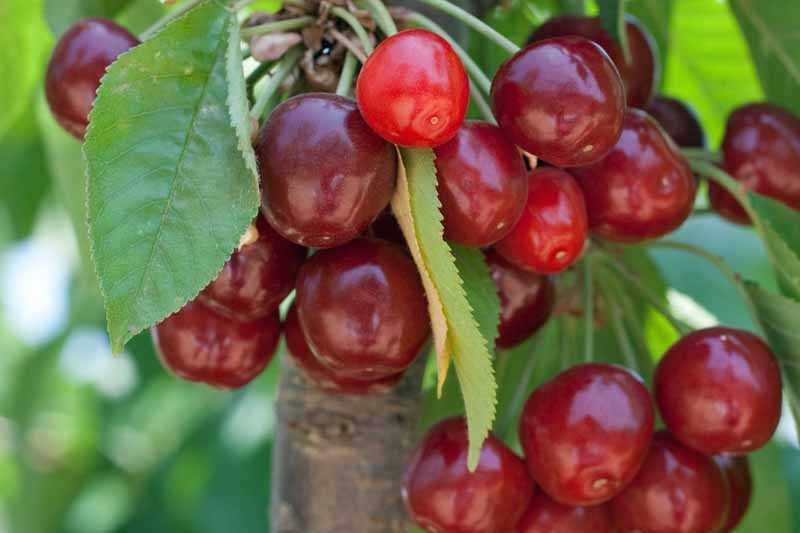
Powdery mildew is a fungal infection that can affect various fruit trees, including cherry trees. It appears as a white powdery coating on the leaves, stems, and fruits. As the infection progresses, the affected parts may become distorted or stunted.
Remedy: To control powdery mildew, it is important to maintain good airflow around the tree by pruning it properly. Applying fungicides at the first sign of infection can help prevent its spread. Regularly monitoring and promptly treating any fungal infections in the surrounding area can also be beneficial.
4. Bacterial Canker:
Bacterial canker is a common disease that affects cherry trees and causes dead or sunken areas on the bark. It can weaken the tree and hinder proper nutrient uptake, leading to reduced fruit production.
Remedy: Pruning and destroying affected branches is essential to control the spread of bacterial canker. Applying copper-based sprays during the dormant season and maintaining good tree health through nutrition and proper irrigation can also help prevent and manage this disease.
Question-answer:
Why is my cherry tree not bearing fruit?
There can be several reasons why your cherry tree is not bearing fruit. Some possible causes include young age, inadequate pollination, improper fertilization, disease or pest infestation, unfavorable weather conditions, excessive pruning, and using incompatible rootstock.
How long does it take for a cherry tree to produce fruit?
The time it takes for a cherry tree to produce fruit can vary depending on the variety and growing conditions. In general, most cherry trees will start producing fruit after 3 to 5 years. However, some varieties may take longer, up to 7 years, to bear fruit.
What can I do to improve pollination for my cherry tree?
To improve pollination for your cherry tree, you can plant another cherry tree of a different variety nearby to ensure cross-pollination. You can also attract pollinators like bees and butterflies to your garden by planting flowers that they are attracted to. Additionally, avoiding the use of pesticides during bloom time can help protect pollinators.
How can I fertilize my cherry tree properly?
To fertilize your cherry tree properly, you should first test the soil to determine its nutrient levels. Based on the results, you can choose a fertilizer with the appropriate balance of nutrients for cherry trees. It is generally recommended to fertilize cherry trees in early spring before new growth begins. Following the fertilizer manufacturer’s instructions, apply the appropriate amount of fertilizer evenly around the base of the tree, avoiding direct contact with the trunk.
What diseases are common in cherry trees?
Cherry trees are susceptible to several diseases, including bacterial canker, brown rot, cherry leaf spot, and powdery mildew. These diseases can cause the tree to not bear fruit or have poor fruit quality. Regularly inspecting your cherry tree for signs of disease, practicing good sanitation, and using appropriate fungicides can help prevent and manage these diseases.
Can pruning affect cherry tree fruit production?
Yes, excessive pruning can affect cherry tree fruit production. Pruning at the wrong time or removing too many branches can disrupt the tree’s ability to produce flowers and fruit. It is important to follow proper pruning techniques and timing specific to cherry trees to maintain a healthy balance between fruit production and tree growth.
Is it possible for cherry trees to be incompatible with rootstocks?
Yes, it is possible for cherry trees to be incompatible with rootstocks. Incompatibility can result in poor growth, lack of fruit production, or even tree decline. It is important to choose a suitable rootstock for the cherry tree variety you are planting to ensure compatibility and optimal growth and fruit production.







